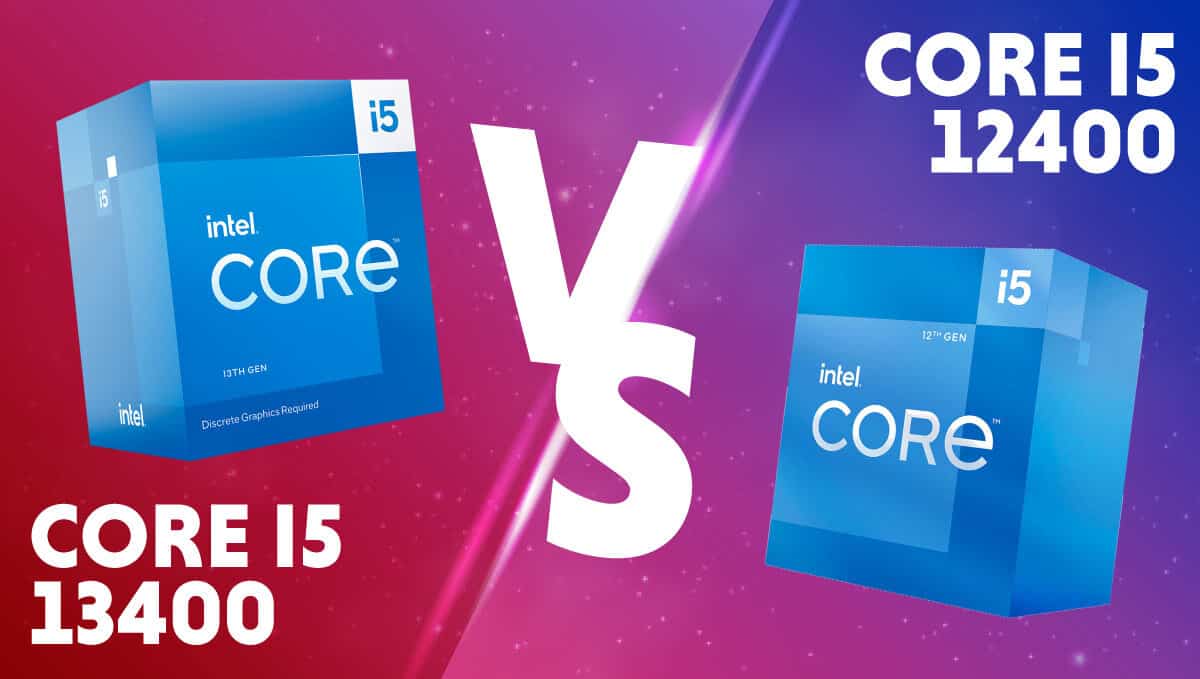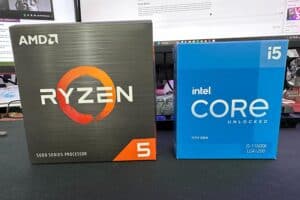Intel Core i5-13400 vs Core i5-12400
Intel Core i5-13400 vs Core i5-12400. Which is better?

WePC is reader-supported. When you buy through links on our site, we may earn an affiliate commission. Prices subject to change. Learn more
The recently released Intel core i5-13400 is the direct successor to the much-loved i5-12400 processor. Let’s see how much Intel has managed to improve the entry-level i5. This is our Intel Core i5-13400 vs Core i5-12400 articles.
Now read: Is the Intel Core i5-13400 good for gaming?
We’ll be comparing both processors in detail and finding out which of the two offers users better value for their money. This is Intel Core i5-13400 vs i5-12400.
Intel Core i5-13400 vs Core i5-12400: Specifications
Before we get into the stat-based comparisons, we need to look at the processors themselves.
Intel Core i5-13400
The Intel Core i5-13400 has the following specs.
- 10 Cores / 20 Threads
- 6 Performance Cores with Hyperthreading (12 Threads)
- 4 Efficiency Cores (4 Threads)
- P.Core Base Clock: 2.5 GHz
- P.Core Boost Clock: 4.6 GHz
- E.Core Base Clock: 1.8 GHz
- E.Core Boost Clock: 3.3 GHz
- L2 Cache: 9.5 MB
- L3 Cache: 20 MB shared
- Default TDP: 65 Watts
- Maximum TDP: 154 Watts
The CPU doesn’t have the highest clock speeds but is a solid gaming processor nonetheless.
Intel Core i5-12400
The Core i5-12400 has these specs:
- 6 Cores / 12 Threads
- Boost Clock: 4.4GHz
- Base Clock: 2.5GHz
- L2 cache: 7.5MB
- L3 cache: 16MB shared
- Default TDP: 65W
- Maximum TDP: 117 Watts
Intel Core i5-13400 vs Core i5-12400: Comparison
Let’s now identify and compare the differences between the two processors.
Architecture
Technically speaking, both processors feature Intel’s hybrid core architecture. But, if you look closely at the 12400’s specs, you’ll quickly realize that’s not actually the case.
The Core i5-12400 has 6 cores and 12 threads. All 6 cores are of a single type – you can consider them performance cores. While Alder Lake processors are indeed based on the hybrid core architecture, you only start seeing efficiency cores in i5-12600 and beyond.
This time around, Intel has included some efficiency cores in the 13400. This means that architecturally, the 13400 has a slight edge over its predecessor. The extra efficiency cores allow it to use up less power while idling.
Clock speed
If you’re wondering what metric dictates how fast a processor “processes,” it’s this one. A CPU’s clock speed represents the frequency with which it executes instructions.
For example, a CPU core with a clock speed of 3.5GHz would execute 3.5 billion instructions per second. The higher the clock speed, the faster the processor, and the better the performance you get.
The newer i5-13400 has a max clock speed of 4.6GHz. This is 200MHz higher than the max clock speed of the 12400, which is 4.4GHz.
Because a processor’s maximum speed is strongly tied to its performance in gaming, the i5-13400 delivers higher framerates when CPU bound. The 12400 is by no means bad for gaming. It’s a great gaming processor in its own right. It’s just a little worse than the 13400.
Core/Thread Count
A CPU’s core count determines its capacity for multitasking. CPUs have multiple smaller microprocessors built onto their chip, which are usually referred to simply as cores.
The more cores a processor has, the more tasks it can do simultaneously. And if it has to process something that can be broken down into multiple smaller subtasks, it can divide the workload across its cores to get things done faster.
The Core i5-13400 is a 10-core, 16-thread processor. The 12400 is a 6-core, 12-thread processor.
Essentially, the difference between the two is the presence of the 4 efficiency cores in the 13400. While efficiency cores are smaller and weaker than performance cores, they are physical cores nonetheless and do pitch in to help the processor out with heavy workloads.
Because of the extra cores, the 13400 can multitask much better than the 12400. Gaming performance isn’t really influenced, since most games run on only a few of the performance cores.
TDP
Both processors have a similar 65-watt base TDP. The 13400 has a max TDP of 154 watts, so it’s a relatively power-hungry processor.
The 12400 is slightly more reserved with a 117-watt max TDP. Still high, but a bit more manageable, especially if using air coolers.
Intel Core i5-13400 vs Core i5-12400: Price
The 13400 has an MSRP of $221, whereas the 12400 launched at a $211 MSRP. Practically the same if you account for inflation.
The 12400 is now a year old, though, and has lost some value. You can find it for under $200 today at most online retailers.
Final thoughts
Overall, both processors are solid mid-range options, but the 13400 comes out ahead in performance.
If you’re only interested in gaming, the 12400 is still a great option. It’s cheaper than the 13400 but has slightly lower gaming performance. On the other hand, if you use your PC for anything other than gaming, I would recommend spending a few extra dollars to go with the 13400.










